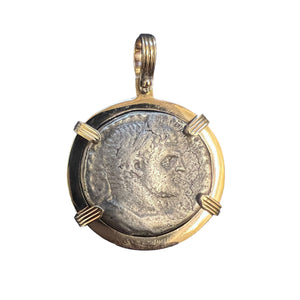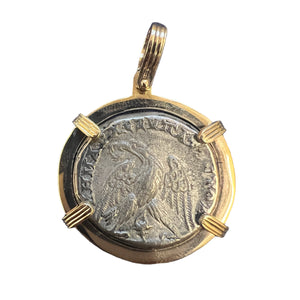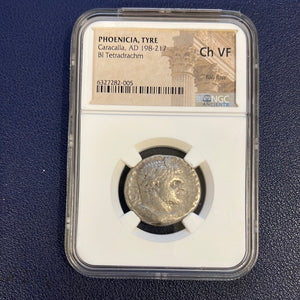Ancient Greece - AR Tetradrachma - "Shekel of Tyre" - Circa 198 - 217 AD
$4,200
Denomination: AR Tetradrachma
Date: 198-217 AD
Mint: Phoenicia, Tyre
Mount: 14K gold
Grade: NGC 6327282-005 - Choice VF
Description: Caracalla (AD 198-217). BI tetradrachm (24mm, 12h). NGC Choice VF, flan flaw. Obverse: ΑΥΤ ΚΑΙ ΑΝ-ΤWΝΙΝΟC CЄ, laureate bust of Caracalla right with drapery on left shoulder, seen from the back Reverse: / •ΔΗΜΑΡX•ЄΞ•ΥΠΑΤΟCΤΟ•Δ•, eagle standing facing on club, head left, wreath in beak, tail left, wings spread; murex shell between legs.
History: The great Phoenician metropolis of Tyre was a place of considerable antiquity, though it is said to have originated as a colony of its rival city Sidon. In 332 BC it put up a stubborn resistance to the advance of Alexander the Great but ultimately fell to the Greek invaders. Later, it formed part of the overseas empire of the Ptolemaic kings of Egypt and, at the end of the 3rd century BC; it passed under the control of the Seleucid king of Syria. Finally, in 126 BC Tyre regained its autonomy and its subsequent coin issues are dated to this event. These include famous “shekels” which stretch in a long sequence down to Roman imperial times. It has been suggested that some of the latest issues of the type, of the Julio-Claudian period, may have been struck in Jerusalem rather than Tyre. Melkarth, who came to be equated with the Greek Heracles, was especially revered at Tyre and appears on the Tyrian coinage from the late 5th century BC. The eagle was inherited from the Seleucid coinage of Tyre issued just prior to the city’s independence.
63150






